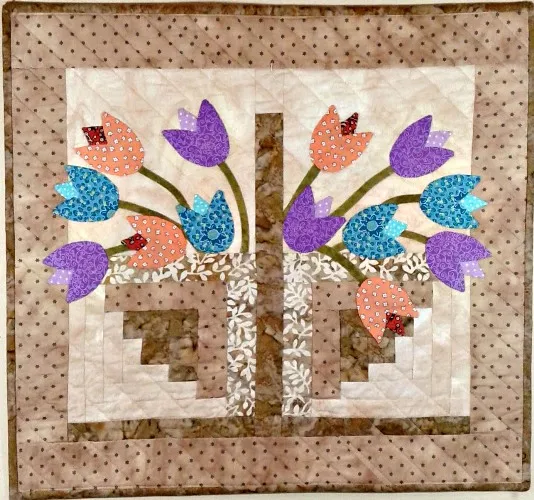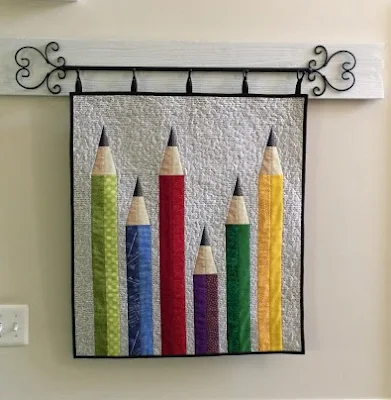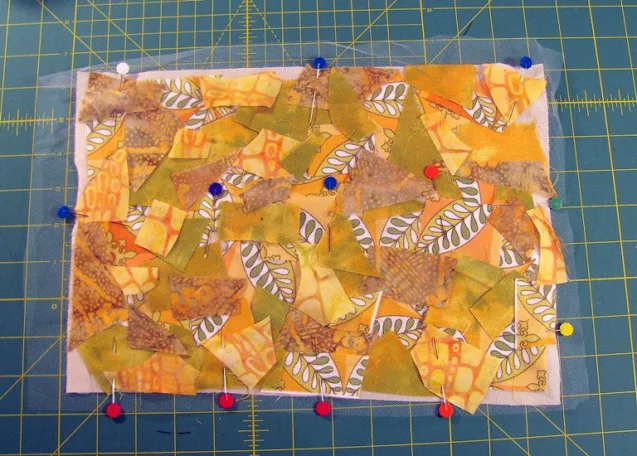I'm excited to be introducing my newest mini quilt pattern Tulip Basket just in time for spring. The basket is two paper pieced log cabins, and the simple tulips are done in hand-stitched appliqué. It measures 19" x 18" (47.5cm x 45cm). This mini quilt uses a soft taupe colour palette inspired by the beautiful quilts by Japanese quilt artist Yoko Saito.
Showing posts sorted by date for query colour. Sort by relevance Show all posts
Showing posts sorted by date for query colour. Sort by relevance Show all posts
CELTIC TWIST Quilt Block | Step-by-Step Tutorial
This tutorial is for the 17" x 17" Celtic twist block shown above. It may look complicated, but it's simple to put together. There are no Y-seams and no templates to worry about. The block consists of two 6 inch units (one is a snowball block) and two different sized triangle units; that's it! You can make one block or add more units to make a quilt or table runner. I love this block for showcasing big prints.
 |
| These are the four units to make the block. |
MATERIALS NEEDED FOR ONE BLOCK
(All measurements include a 1/4 inch seam allowance)
Unit 1 - Makes 4
[8] 5" x 2" dark print
[8] 5" x 2" light print
[4] 3½" x 3½" medium print
Unit 2 - Makes 4
[1] 7¼" solid
Unit 3 - Makes 4
[2] 7" solid
[4] 2" x 2" dark print
Unit 4 - Makes 1
[1] 6½" x 6½" large print
[4] 2" x 2" light print
UNIT 1 - Make 4
1. Arrange your fabric pieces to ensure you have the correct colour placement. You'll need [2] 5" x 2" dark print; [2] 5" x 2" light print; and [1] 3½" square medium print to make one 6" block.

2. Place the square and first piece right sides facing and start stitching 1 inch from the top of the square.

3. Flip and press the first piece. Place the next piece right sides facing and stitch to end.

4. Flip and press the last piece you stitched. Place the next piece right sides facing and stitch to end.

5. Flip and press the last stitch pieced. Pull back and pine the first piece sewn on and pin back. Place the last piece right sides facing and stitch to end. Flip back and press.

6. Fold back the first piece as shown and stitch to just past the starting point of your first stitches.

7. Press completed block.

UNIT 2 (One square makes four triangles)
1. Cut [1] 7¼ solid colour square.
2. Cut the square diagonally to each corner to make four triangles.

UNIT 3 - Make 4
1. Pin one [1] 2" dark print square with right sides facing on opposite corners of the 7" solid colour square and stitch as shown. Cut a 1/4 inch seam allowance from each corner square, flip and press back.

2. Cut from corner to corner parallel to stitched corners to make two triangles.


UNIT 4 - Make 1
1. Cut [1] 6½ inch large print square and [4] 2" light print squares. Pin one 2" square with right sides facing on each corner of the larger square as shown.

2. Cut a corner inch seam allowance from each corner square, flip back, and press.


1. Cut [1] 6½ inch large print square and [4] 2" light print squares. Pin one 2" square with right sides facing on each corner of the larger square as shown.

2. Cut a corner inch seam allowance from each corner square, flip back, and press.


BLOCK ASSEMBLY DIAGRAM


Polly makes my pencil quilt
One of the most rewarding things as a quilt designer is seeing how other quilters interpret my patterns. I was so pleased to recently see one of my most popular patterns, Pencil Me In, created by Polly at Aunt Polly's Porch. I think she did a beautiful job with this pattern. Her colour choices are stunning, and I love the hanging tabs she put on the top.
Kandinsky Revisited: Inspiration for a new art quilt
When I was an art student, I became fascinated by the art of Wassily Kandinsky. I loved his playfulness with shapes and colour. I also saw that his style would translate very well into quilt applique and created this art quilt below.
 |
| Mystic Bird Art Quilt by Monica Curry |
 |
| Untitled (Kandinsky Inspired) by Monica Curry |
I've recently been wanting to try something different, so I thought I'd revisit my Kandinsky phase; I'm glad I did. Recently, I found other quilts inspired by Kandinsky and discovered Kandinsky quilts are quite a thing in the quilting world.
Below are a few examples of the Kandinsky quilts I found recently. You can see that Kandinsky's art translates extremely well into art quilts. If you want some inspiration for your own Kandinsky quilt, check out wassily kandinsky.net where you'll find a catalogue of Kandinsky's artwork.
Patricia Bravo - My Vision of Kandinsky
The Vision of Kandinsky quilt pattern is one of three patterns by quilter and fabric designer Patricia Bravo. Update: July 07, 2021. The Kandinsky patterns by Patricia Bravo are no longer available.Lolly Quilts
Check out these gorgeous Kandinsky quilts at the Lollyquiltzs Kandinsky Challenge.
Carol J. Floyd - Kandinsky and Me
Kandinsky and Me. This is an award winning Kandinsky quilt from the 2010 American Quilt Society Quilt Show & Contest in Des Moines, Iowa.
Don't Call Me Becky
Inspired by the Kandinsky classic, Color Study, Squares with Concentric Circles. This quilt was created by Rebekah at Don't Call Me Becky.Kandinsky Goes to the Bahamas by Daniela Schupp for the Art Quilt Association Inspired by the Masters Show


4 Quilting Apps You Can Not Live Without: 2016
"Master the math involved in quilting! Robert Kaufman Fabrics and Quilters Paradise have joined forces to bring you this updated collection of eight essential quilting calculators. Designed by quilters, the calculators work with both U.S. and metric measurements. With these tools you’ll easily and accurately work out how many rectangular pieces can be cut from a larger piece, or how much fabric is needed for backing, batting and borders, square-in-a-square, set-in and corner triangles."
I love this app because it does all the quilting math work for you, which is great for me because I'm pretty much math-challenged. It has several calculations, but my favorites are backing and batting measurements, binding yardage needed, and piece count (calculates the number of pieces you can cut from a larger piece of fabric).
2. Quilt Creator by Crochet Designs
"Create quilts using over 200 quilt blocks to select from. You can then change the colors in the blocks to get the look you want."
2. Quilt Creator by Crochet Designs
"Create quilts using over 200 quilt blocks to select from. You can then change the colors in the blocks to get the look you want."
3. How Much Thread by Superior Threads (This app is no longer available)
4. Color Gear by Appsvek ($1.99)
"Color Gear is a handy professional tool that helps to create harmonious colour swatches. To find the perfect colour combination, designers and artists use colour theory and the basis of it: colour wheel and harmonies. You don't need to be a colour expert in order to use this app – Color Gear is a user friendly application suitable for beginners and pro. Perfect app for understanding colour theory and daily working with palettes. Works offline."
4. Color Gear by Appsvek ($1.99)
"Color Gear is a handy professional tool that helps to create harmonious colour swatches. To find the perfect colour combination, designers and artists use colour theory and the basis of it: colour wheel and harmonies. You don't need to be a colour expert in order to use this app – Color Gear is a user friendly application suitable for beginners and pro. Perfect app for understanding colour theory and daily working with palettes. Works offline."
How To Make Fabric Foundations for Fabric Art
Fabric sandwiches were incorporated into my art quilt Mother Ship that's on the Fall 2012 Quilting Arts Magazine cover in Fall 2012.
 |
| Sister Moon by Monica Curry |
 |
| Knowledge by Monica Curry |
INSTRUCTIONS
YOU WILL NEED
2. MIDDLE LAYER
3. TOP LAYER
- Fabric scraps.
- Lightweight muslin or any lightweight non-stretchy fabric cut to 9 x 12 inches.
- One piece of tulle cut to 11 x 14 inches.
- Thread
- Pins
- Sewing machine
1. FOUNDATION LAYER
Start your sandwich with a lightweight, non-stretchy, foundation piece approximately 9 inches by 12 inches. This is the easiest size to work with. I use a light, inexpensive muslin for the foundation, but anything lightweight and non-stretchy will work. You can also use a coloured foundation that works with the scrap colours.
Pick the colours you want to work with. You can use monochromatic colours, contrasting colours, or grab a bunch of random colours. Start placing your fabric scraps down on the foundation until you've covered it as much as you can.
3. TOP LAYER
After all the scraps are put down on your foundation layer, cover these two layers with a piece of tulle about two inches wider than your foundation piece (11" x 14") giving you an overhang of 1 inch all the way around. Pin these three layers down around the edges and in the middle.
6. When you’ve completed stitching your grid, you now get a chance to use some of those decorative stitches you have on your sewing machine. If you’re like me, you may not use them very often. Pick a decorative stitch and, starting at one edge of the sandwich, sew to the other edge. There is no hard and fast rule about this. Just pick out a bunch of nice stitches to use and sew along the sandwich randomly. I experimented with my alphabet stitch for this project and really liked the outcome. You can also use free-motion stitching which can produce some beautiful results.
7. When all your stitching is complete, trim the excess tulle along the outer seam line to clean up the edges. I do this because I find the excess tulle snags on things when you work with the sandwich later.
8. Turn the sandwich over face down and press on the wrong side so you don’t gum up your iron with melted tulle. You can see in this photo the grid width and where I’ve sewn the decorative stitches randomly across the sandwich.
4. STITCH AROUND OUTER EDGE
Once the three layers are pinned securely, stitch around the edge of the sandwich with a basting stitch creating a seam width of about 1/2 inch.5. QUILT
After you’ve sewn around the edge, sew a line across the length and the width of the sandwich. Then stitch a grid at least 3" in width. Your grid can be as small as you like, but don’t go wider than 3" because your scraps could start to shift around too much during the next step.6. When you’ve completed stitching your grid, you now get a chance to use some of those decorative stitches you have on your sewing machine. If you’re like me, you may not use them very often. Pick a decorative stitch and, starting at one edge of the sandwich, sew to the other edge. There is no hard and fast rule about this. Just pick out a bunch of nice stitches to use and sew along the sandwich randomly. I experimented with my alphabet stitch for this project and really liked the outcome. You can also use free-motion stitching which can produce some beautiful results.
7. When all your stitching is complete, trim the excess tulle along the outer seam line to clean up the edges. I do this because I find the excess tulle snags on things when you work with the sandwich later.
8. Turn the sandwich over face down and press on the wrong side so you don’t gum up your iron with melted tulle. You can see in this photo the grid width and where I’ve sewn the decorative stitches randomly across the sandwich.
TIPS
- Sprinkle thread, ribbon, yarn, or lace scraps on top of the fabric layer before adding the tulle layer.
- Try using a foundation piece made from used dryer sheets that have been stitched together.
- Print images or lettering on fabric that can be incorporated into the scrap layer.
- If the piece isn’t going to be washed, add bits of pretty paper or newsprint to the scrap layer.
- Use a foundation piece colour to coordinate with the scraps.
- Experiment and have fun!
Subscribe to:
Posts (Atom)


.jpg)
























